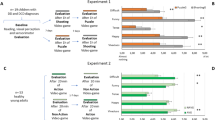Abstract
We conducted assessments of 28 children with impaired vision (VI group), with ages ranging from 12 to 17 years, and an equal number of age-matched, normal-sighted children (NS group). The VI group had significantly higher rates of breathing, heart rates, and diastolic blood pressure values compared to the NS group (Mann–Whitney U test). Twenty-four of the VI group formed pairs matched for age and degree of blindness, and we randomly assigned members of the pairs to two groups, viz., yoga and physical activity. Both groups spent an hour each day practicing yoga or working in the garden, depending on their group. After 3 weeks, the yoga group showed a significant decrease in breath rate (Wilcoxon paired signed ranks test). There was no change after the physical activity program. The results showed that children with visual impairment have higher physiological arousal than children with normal sight, with a marginal reduction in arousal following yoga.
Similar content being viewed by others
REFERENCES
Ax, A. F. (1953). The physiologic differentiation between fear and anger in humans. Psychosom. Med. 15: 433–442.
Bloch, S., Lemeignan, M., and Aquilera, T. N. (1991). Specific respiratory patterns distinguish among human basic emotions. Int. J. Psychosom. 11: 141–154.
Fenz, W. D., and Jones, G. B. (1972). Individual differences in physiologic arousal and performances in sports parachutists. Psychosom. Med. 34: 1–8.
Hopkins, W. D., Gaeta, H., Thomas, A. C., and Hill, P. M. (1987). Physical fitness of blind and sighted children. Eur. J. Appl. Physiol. 56(1): 69–73.
Joseph, S., Sridharan, S. K. B., Patil, M. D., Kumaria, A., Selvamurthy, W., Joseph, N. T., and Nayar, H. S. (1981). Study of some physiological and biochemical parameters in subjects undergoing yogic training. Indian J. Med. Res. 74: 120–124.
Nagendra, H. R. (1989). Yoga—Its Basis and Applications, Vol. I, Vivekananda Kendra Yoga Anusandhan Samasthan, Bangalore.
Ollendick, T. H., Matson, J. L., and Helsel, W. J. (1985). Fears in visually impaired and normal sighted youths. Behav. Res. 23(3): 375–378.
Sheridan, M. D. (1969). Vision screening procedures for very young children or handicapped children. In Gardiner, P. A., MacKeith, M. A. C., and Smith, V. (eds.), Aspects of Developmental and Pediatric Ophthalmology. Clinics in Developmental Medicine, Heinemann Medical, London, pp. 39–40.
Telles, S., Narendran, S., Raghuraj, P., Nagarathna, R., and Nagendra, H. R. (1997). Comparison of changes in autonomic and respiratory parameters of girls after yoga and games at a community home. Percept. Motor Skills 84: 251–257.
Wallace, R. K., Benson, H., and Wilson, A. F. (1971). A wakeful hypometabolic physiologic state. Am. J. Physiol. 221: 795–799.
Williams, J. G. P., and Sperryn, P. N. (1962). Sports Medicine, Edward Arnold, London.
Wycherley, R. J., and Wicklin, B. H. (1970). The heart rate of blind and sighted pedestrians on a town route. Ergonomics 13(2): 181–192.
Author information
Authors and Affiliations
Rights and permissions
About this article
Cite this article
Telles, S., Srinivas, R.B. Autonomic and Respiratory Measures in Children with Impaired Vision Following Yoga and Physical Activity Programs. International Journal of Rehabilitation and Health 4, 117–122 (1998). https://doi.org/10.1023/A:1022912626238
Issue Date:
DOI: https://doi.org/10.1023/A:1022912626238




